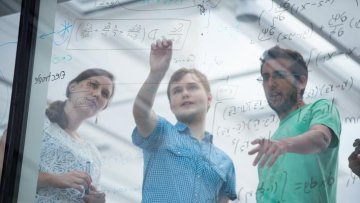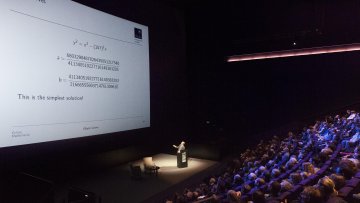Stratified hyperkähler spaces
Abstract
Symplectic reduction is the natural quotient construction for symplectic manifolds. Given a free and proper action of a Lie group G on a symplectic manifold M, this process produces a new symplectic manifold of dimension dim(M) - 2 dim(G). For non-free actions, however, the result is usually fairly singular. But Sjamaar-Lerman (1991) showed that the singularities can be understood quite precisely: symplectic reductions by non-free actions are partitioned into smooth symplectic manifolds, and these manifolds fit nicely together in the sense that they form a stratification.
Symplectic reduction has an analogue in hyperkähler geometry, which has been a very important tool for constructing new examples of these special manifolds. In this talk, I will explain how Sjamaar-Lerman’s results can be extended to this setting, namely, hyperkähler quotients by non-free actions are stratified
spaces whose strata are hyperkähler.
Today, Thursday 7th December 2017, Oxford Mathematics will be holding its second Graduate Virtual Open Day, from 15:00-16:00 (UK time). This year, the Virtual Open Day will be focusing on taught masters' courses offered at the Mathematical Institute, which will include the following degrees:
Michael Berry - Chasing the dragon: tidal bores in the UK and elsewhere
Abstract
Oxford Mathematics Public Lectures
Hooke Lecture
Michael Berry - Chasing the dragon: tidal bores in the UK and elsewhere
15 November 2018 - 5.15pm
In some of the world’s rivers, an incoming high tide can arrive as a smooth jump decorated by undulations, or as a breaking wave. The river reverses direction and flows upstream.
Understanding tidal bores involves
· analogies with tsunamis, rainbows, horizons in relativity, and ideas from quantum physics;
· the concept of a ‘minimal model’ in mathematical explanation;
· different ways in which different cultures describe the same thing;
· the first unification in fundamental physics.
Michael Berry is Emeritus Professor of Physics, H H Wills Physics Laboratory, University of Bristol
5.15pm, Mathematical Institute, Oxford
Please email @email to register.
Watch live:
https://www.facebook.com/OxfordMathematics
https://livestream.com/oxuni/Berry
Oxford Mathematics Public Lectures are generously supported by XTX Markets.
Loops from the Nodal Riemann Sphere: 2-loop gravity amplitudes from the Ambitwistor String
In the first Oxford Mathematics London Public Lecture, in partnership with the Science Museum, world-renowned mathematician Andrew Wiles lectured on his current work around Elliptic Curves followed by an-depth conversation with mathematician and broadcaster Hannah Fry.
In a fascinating interview Andrew talked about his own motivations, his belief in the importance of struggle and resilience and his recipe for the better teaching of his subject, a subject he clearly loves deeply.
Earth absorption
16:00
Mazur's Eisenstein ideal
Abstract
In his landmark 1976 paper "Modular curves and the Eisenstein ideal", Mazur studied congruences modulo p between cusp forms and an Eisenstein series of weight 2 and prime level N. He proved a great deal about these congruences, and also posed some questions: how many cusp forms of a given level are congruent to the Eisenstein series? How big is the extension generated by their coefficients? In joint work with Preston Wake, we give an answer to these questions in terms of cup products (and Massey products) in Galois cohomology. Time permitting, we may be able to indicate some partial generalisations of Mazur's results to square-free level.



